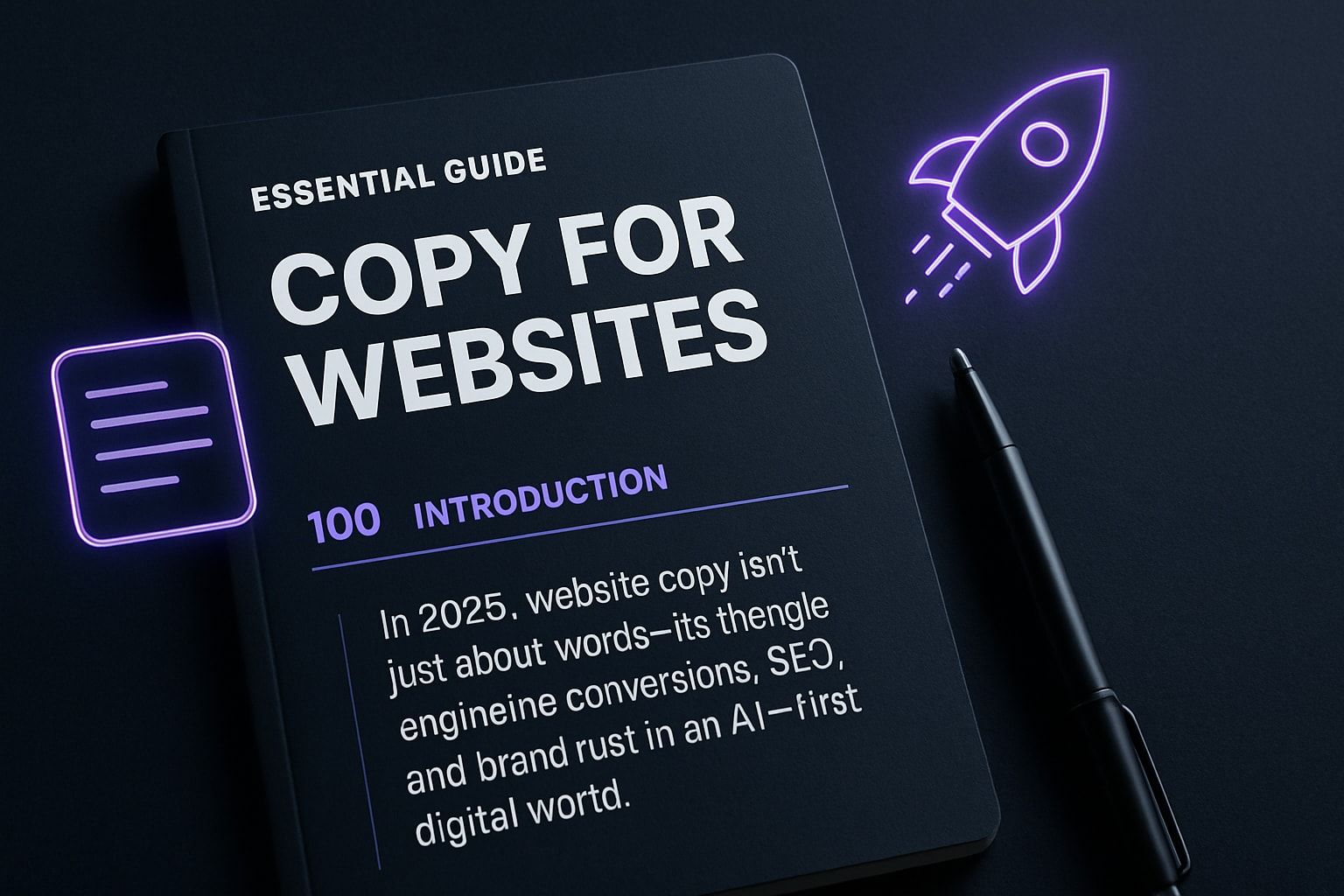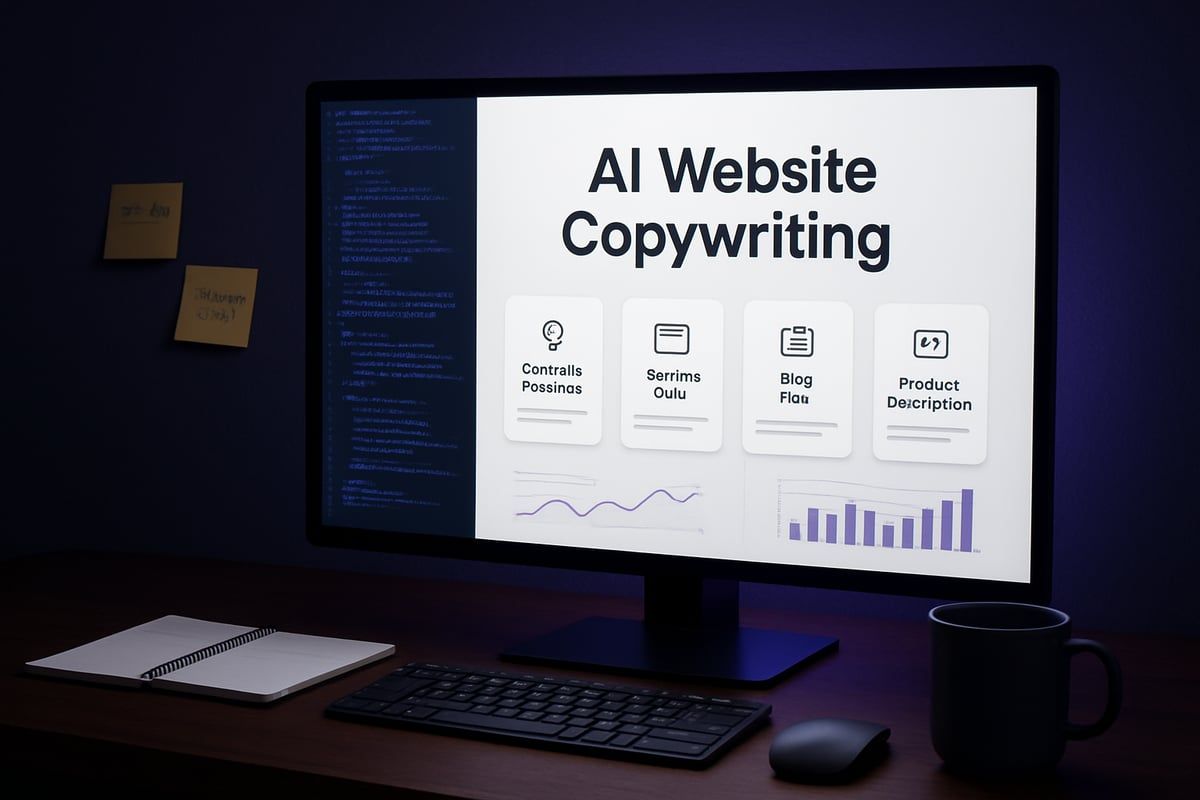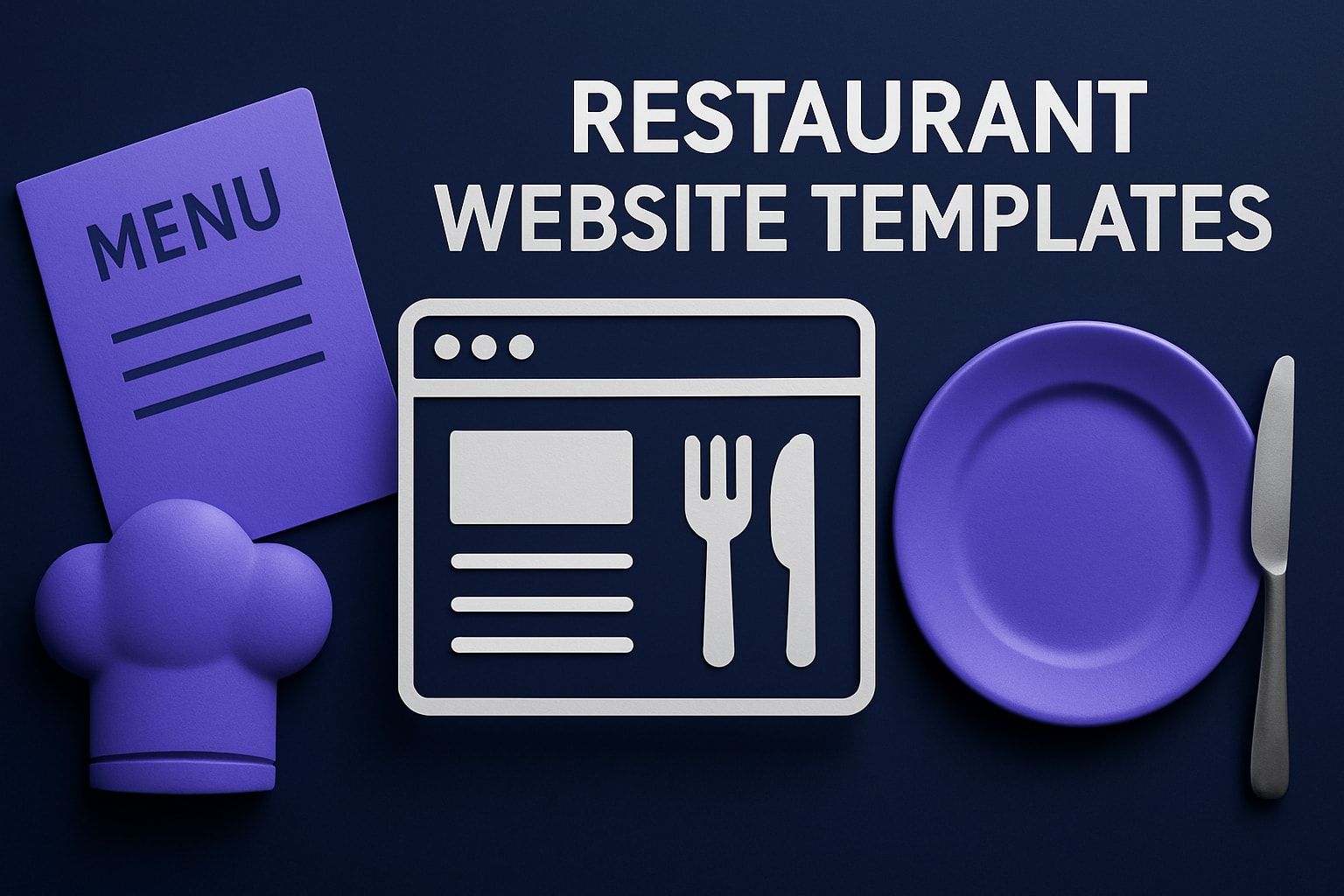The Essential Guide to Copy for Websites in 2025

By Pietro Saman • November 10, 2025
In 2025, copy for websites has become the foundation of digital success. It is no longer just about writing words, but about driving conversions, building SEO strength, and earning trust in an AI-first world.
This guide will help you master copy for websites by blending timeless strategies with the latest trends and technologies. We will explore how user behaviors are shifting, how SEO is evolving, and how AI is transforming content creation.
You will also learn actionable steps to craft compelling copy that not only attracts visitors but turns them into loyal customers. Ready to elevate your site and get ahead? Let’s dive in.
The Evolution of Website Copy: Trends and Insights for 2025
In 2025, the landscape of copy for websites is evolving faster than ever. User habits, technology, and content standards are reshaping what works online. Let’s break down the most important shifts every web writer and business owner should know.

Changing User Behaviors and Expectations
Today’s web users crave instant value. If your copy for websites isn’t clear or engaging within seconds, most visitors will leave. According to Nielsen Norman Group, 67 percent of users bounce if they don’t find what they need in 10 seconds. Mobile-first experiences are now the default, and content must be accessible and inclusive for all. Simple language and clear structure make information easy to digest, no matter the device or ability.
The Rise of Conversational and Human-Centric Copy
Brands are moving away from stiff, formal language. Conversational tones—using “you” and “we”—lead to 30 percent higher engagement rates. Audiences want to feel like they’re in a dialogue, not reading a corporate memo. Copy for websites that feels genuine and direct, like the playful styles of Duolingo or Slack, builds stronger relationships and keeps users coming back for more.
Visual-First and Multimedia Integration
Copy for websites is no longer just about text. It now works hand in hand with videos, infographics, and micro-interactions. Modern web pages use visuals to capture attention, while concise copy guides users through the journey. Every sentence should support the visuals, providing context or calls to action that move users forward. When words and images align, engagement and retention soar.
Personalization and Dynamic Content
Personalized experiences are now expected. Real-time, user-tailored copy for websites can boost conversions by up to 42 percent, according to HubSpot. AI-powered tools enable dynamic content blocks that change based on user behavior or location. When visitors feel like a site “knows” them, they’re more likely to trust and interact with the brand.
Data-Driven Copywriting Decisions
Modern copy for websites isn’t guesswork. Brands use A/B testing and analytics to discover what works best, from tone to CTA placement. For example, Booking.com tests their copy constantly, refining headlines and messages based on user data. This approach ensures every word is optimized for clarity and conversion, not just intuition.
SEO and Content Discoverability in 2025
SEO is evolving with Google’s SGE, which now favors helpful, expert content. Semantic search and E-E-A-T (Experience, Expertise, Authoritativeness, Trustworthiness) are vital for ranking. If you want your copy for websites to be discovered, it needs to be original, informative, and credible. For more on this, check out Google's Search Generative Experience Overview, which explains how content quality now drives visibility.
The Impact of AI and Automation
AI is transforming how we create and optimize copy for websites. Tools now assist with drafting, editing, and even personalizing content at scale. However, human oversight is essential to maintain authenticity and a unique brand voice. The best results come when AI and humans collaborate, ensuring every message resonates with real people.
Core Principles of High-Converting Website Copy
Creating high-converting copy for websites in 2025 means combining timeless principles with new approaches tailored for today’s users. Let’s break down the essential elements that make web copy truly effective.

Clarity, Brevity, and Value Proposition
Clarity is the backbone of successful copy for websites. Users want to know what you offer, fast. Use short sentences and simple language to get your message across.
Highlight your unique value proposition (UVP) in a prominent spot. Make it benefit-driven, so visitors instantly understand what’s in it for them.
- Avoid jargon and fluff
- Place your UVP above the fold
- Focus on the customer’s needs
A clear, concise approach helps your copy for websites outperform lengthy, complicated text.
Storytelling and Brand Voice
Storytelling gives your copy for websites an emotional edge. Tap into real stories or scenarios that resonate with your audience, and use a consistent brand voice for every page.
Define your voice—whether friendly, authoritative, or witty—and stick to it. This builds recognition and trust.
- Share quick customer success stories
- Use “you” and “we” to connect
- Keep tone consistent across touchpoints
When users feel a story, they remember your brand and your copy for websites.
Persuasive Techniques and Psychological Triggers
Boost conversions by weaving proven psychological triggers into your copy for websites. Scarcity, urgency, social proof, and authority all play a role in prompting action.
| Trigger | Example |
|---|---|
| Scarcity | “Only 3 spots left!” |
| Urgency | “Sale ends tonight” |
| Social Proof | Testimonials with photos |
| Authority | “Trusted by 10,000+ users” |
Mix these triggers naturally to avoid sounding pushy. Effective copy for websites guides, not pressures, users to act.
Calls to Action (CTAs) That Work
A strong CTA is the heartbeat of copy for websites. Make your CTAs action-oriented and specific, so users know exactly what happens next.
- Use verbs like “Start,” “Get,” or “Discover”
- Highlight benefits (“Get your free guide”)
- A/B test CTA variations for best results
CTAs should stand out visually and tie back to your value proposition. The right CTA turns interest into action within your copy for websites.
Trust Signals and Credibility
Trust is critical for conversion. Strengthen your copy for websites with visible endorsements, certifications, and authentic testimonials.
Include recognizable badges, awards, or customer reviews. According to Google’s E-E-A-T Guidelines, demonstrating expertise and trustworthiness is essential for both users and SEO.
- Add third-party endorsements
- Display security or guarantee seals
- Use real names and photos for testimonials
Trust signals reassure visitors that your copy for websites is reliable and worth their time.
Accessibility and Inclusivity
Accessible copy for websites reaches everyone. Use plain language, descriptive alt text, and avoid idioms that may confuse non-native speakers.
Check your copy against accessibility standards. This ensures users with disabilities can navigate and understand your content easily.
- Write short, clear sentences
- Provide alt text for images
- Avoid jargon and cultural references
Inclusive copy for websites extends your reach and builds goodwill with every visitor.
Mobile Responsiveness and Microcopy
Over half of web traffic is mobile, so your copy for websites must be concise and easy to scan. Microcopy—like button labels and error messages—guides users through every step.
Keep paragraphs short and use bullet points or headings to break up text. Effective microcopy reduces friction and helps users complete tasks seamlessly.
- Use clear, direct button text
- Write helpful error messages
- Test readability on small screens
Prioritizing mobile-friendly copy for websites ensures you engage users wherever they are.
Step-by-Step Process: Crafting Effective Website Copy in 2025
Crafting compelling copy for websites in 2025 is a mix of art, science, and technology. The process is more strategic than ever, starting with research and ending with ongoing optimization. Let’s break down the essential steps you need to follow to ensure your site’s copy is engaging, accessible, and primed for conversions.

Step 1: Research Audience and Competitors
Before writing any copy for websites, start with deep research. Understand your audience’s needs, pain points, and motivations. Build user personas using analytics, surveys, and interviews.
- Analyze competitors’ messaging to identify gaps and opportunities.
- Look for unique selling points that set your brand apart.
- Create a table comparing competitor value propositions and tone.
| Competitor | Value Proposition | Tone/Style |
|---|---|---|
| Brand A | Fast delivery | Friendly |
| Brand B | Low prices | Direct |
| You | Personalized help | Expert |
Effective research lays the foundation for relevant, high-impact copy for websites that resonates with your target users.
Step 2: Define Brand Voice and Tone
Your brand’s personality should shine through every line of copy for websites. Develop a brand voice chart to clarify how your brand “sounds.”
For example:
| Scenario | Voice | Tone |
|------------------|------------|-------------|
| Homepage | Expert | Welcoming |
| Error Page | Supportive | Reassuring |
| Blog | Insightful | Conversational |
Document your tone variations for different contexts. Consistency in voice builds trust and recognition, making your copy for websites memorable.
Step 3: Structure Pages for User Intent
Every page on your site should serve a clear purpose. Map user journeys to understand what visitors want from each page.
- Use clear headings and subheadings to guide users.
- Organize information in logical sequences.
- Make sure each section answers a specific user intent.
This structure ensures your copy for websites is easy to scan and encourages visitors to take action.
Step 4: Write Compelling Headlines and Subheadings
Headlines are the first thing users see. Since 80% of visitors read only headlines, make every word count.
- Use power words, numbers, and direct value statements.
- Test variations to see what grabs attention.
- Keep subheadings relevant and informative.
A strong headline draws readers in, making them more likely to engage with your copy for websites.
Step 5: Draft Body Copy with Clarity and Persuasion
When drafting body copy for websites, focus on benefits instead of just features. Use short paragraphs, bullet points, and active voice for better readability.
- Highlight what users gain by choosing you.
- Address pain points directly.
- Use persuasive language, but avoid hype.
Here’s an example of benefit-driven copy for websites:
“Get expert support 24/7, so your business never misses a beat.”
Step 6: Optimize for SEO and Semantic Search
To ensure your copy for websites is discoverable, integrate primary and secondary keywords naturally. Focus on semantic search and user intent.
- Use schema markup, FAQs, and long-tail keyword variations.
- Regularly update content for freshness and relevance.
For a deeper dive into SEO strategies that work for copy for websites, check out SEO Optimization for Web Copy.
Step 7: Personalize and Localize Content
Personalization is key in 2025. Adapt your copy for websites to different audience segments, regions, and devices.
- Use dynamic greetings based on user location or time.
- Translate and localize content for global reach.
- Tailor messaging for repeat visitors versus new ones.
Personalized copy for websites increases engagement and drives conversions.
Step 8: Edit, Test, and Iterate
The final step is refining your copy for websites through editing and testing. Use AI tools for grammar and clarity checks. Run A/B tests on headlines, CTAs, and layouts.
- Gather feedback from real users.
- Monitor analytics for performance insights.
- Iterate regularly to improve results.
Continuous improvement keeps your copy for websites relevant, engaging, and high-converting.
Integrating AI and Automation in Website Copywriting
Artificial intelligence is rapidly transforming how businesses approach copy for websites. The integration of automation and smart tools is not just a trend, but a foundational shift in digital content creation. Brands that leverage AI in their copy for websites are finding new ways to scale, personalize, and optimize their messaging with more efficiency than ever before.

The Role of AI in Content Generation and Optimization
AI tools have become essential for drafting, editing, and refining copy for websites at scale. These solutions can generate headlines, summarize product details, and suggest improvements based on real-time data. For example, the AI Content Assistant Features offered by Avantiy enable teams to produce high-quality copy for websites with minimal manual effort. AI can analyze performance metrics and user behavior, helping creators fine-tune content for engagement and conversions.
Human–AI Collaboration: Maintaining Authenticity
While AI can accelerate the copywriting process, human creativity and oversight are still vital. Automated tools provide a strong starting point for copy for websites, but only people can ensure that messaging aligns with brand values and resonates emotionally. Effective collaboration involves reviewing, editing, and personalizing AI-generated drafts to maintain a consistent brand voice and genuine connection with users.
Automated Personalization at Scale
AI-driven personalization engines are revolutionizing how brands deliver tailored messages on their websites. By analyzing visitor behavior, preferences, and demographics, these systems can dynamically adjust copy for websites in real time. This level of customization increases relevance, which in turn boosts engagement and conversions. Imagine landing pages that greet users by name or showcase products based on their recent browsing activity.
AI-Driven SEO Enhancements
Optimizing copy for websites now goes far beyond keyword stuffing. Modern AI tools track search trends, recommend high-impact keywords, and optimize meta tags for better visibility. They can also help structure content for semantic search and Google’s evolving algorithms. Using AI in SEO ensures that copy for websites remains discoverable, relevant, and competitive in a crowded digital landscape.
Addressing Risks: Plagiarism, Bias, and Accuracy
With the rise of AI-generated copy for websites, it is crucial to address potential risks. Automated systems can unintentionally introduce plagiarism or reflect biases present in their training data. To mitigate these issues, regularly use plagiarism checkers, implement ethical guidelines, and conduct manual reviews. Ensuring factual accuracy is essential for maintaining trust and credibility with your audience.
Future-Proofing Your Copy with AI
Staying ahead in website copywriting means continually adapting to new AI capabilities. Invest in training your team on the latest tools and best practices for copy for websites. Monitor industry standards, update workflows, and remain flexible as technology evolves. By embracing both automation and human expertise, your website copy will be ready to meet the demands of 2025 and beyond.
UX Writing and Microcopy: Enhancing User Experience with Words
Crafting effective copy for websites in 2025 means thinking beyond catchy phrases. Great UX writing is the invisible hand guiding visitors through each page, ensuring every step feels natural, intuitive, and even delightful.
The right words can help users complete tasks faster, reduce confusion, and build trust with your brand. As digital spaces become more interactive, focusing on UX copy for websites is essential to keep users engaged and satisfied.
The Importance of UX Writing in Modern Websites
UX writing sits at the heart of every successful digital experience. When your copy for websites is clear and purposeful, users know exactly what to do next.
Research shows that concise UX copy can increase task completion rates by up to 30 percent. That means less frustration and more conversions for your site.
Small choices in wording—like “Get Started” instead of “Submit”—make a big difference. Every word should serve a purpose and match user intent.
Principles of Effective Microcopy
The best microcopy is simple, direct, and always context-aware. When writing copy for websites, think about what the user needs to know at each moment.
Key principles include:
- Clarity: Use words everyone understands.
- Brevity: Keep it short and to the point.
- Positivity: Encourage users with helpful, upbeat language.
Effective microcopy guides users, reassures them, and reduces uncertainty throughout their journey.
Error Messages and Help Text
Even with the best design, users make mistakes. That’s why strong error messages are a crucial part of copy for websites.
Empathetic error text, like “Oops! That email doesn’t look right. Try again?” turns a setback into a gentle nudge. Help text should be clear, specific, and easy to spot.
Always offer users a way to fix mistakes, rather than just pointing out what went wrong.
Navigation and Onboarding Copy
Navigation labels and onboarding steps are the roadmap for any site. Clear copy for websites ensures visitors know where they are and how to move forward.
Swap vague terms for action-based phrases. For example, use “Start your free trial” instead of “Sign up.” Onboarding tips should be short, friendly, and guide users through the first steps.
The right onboarding copy can boost engagement and lower drop-off rates.
Accessibility in UX Copy
Making copy for websites accessible is non-negotiable. Use descriptive labels, avoid jargon, and make sure your text works for all users, including those using screen readers.
Check your work against the Web Content Accessibility Guidelines (WCAG) Overview to ensure your copy is inclusive. Add alt text for images and make navigation clear for everyone.
Accessible UX copy opens your site up to a wider audience and shows you value every visitor.
Voice and Tone Consistency Across Microcopy
Consistency is key for building trust. Your copy for websites should sound like your brand, whether it’s a playful tooltip or a formal confirmation screen.
Establish guidelines for voice and tone so every team member writes in harmony. Consistent language across all microcopy makes your brand memorable and reliable.
Testing and Iterating UX Copy
Improving copy for websites is an ongoing process. Use heatmaps, user testing, and analytics to see where users get stuck or confused.
A/B test different wordings for buttons, forms, and tooltips. Gather feedback and refine your microcopy regularly to keep it effective and user-friendly.
Iterative testing ensures your site’s words always support your goals and your users’ needs.
Measuring and Optimizing Website Copy Performance
Measuring how your copy for websites performs is essential if you want to boost engagement, conversions, and user trust. It’s not enough to write and publish—constant optimization is the name of the game in 2025. Let’s look at how to evaluate, test, and refine your messaging so every word works harder.
Key Metrics for Evaluating Copy Effectiveness
To make informed decisions about copy for websites, track the right metrics. Focus on bounce rate, time on page, conversion rate, and scroll depth. These numbers reveal how visitors interact with your content and where they might drop off.
Here’s a quick summary:
| Metric | What It Shows |
|---|---|
| Bounce Rate | If users leave after one page |
| Time on Page | Engagement with your content |
| Conversion Rate | How many complete desired actions |
| Scroll Depth | If users see your full message |
Consider integrating user-generated content where possible, as trust statistics show authentic content can increase conversion rates.
Tools for Analytics and A/B Testing
Leverage analytics platforms to monitor how your copy for websites performs. Google Analytics tracks user behavior, while tools like Hotjar visualize user journeys through heatmaps.
For optimization, use A/B testing platforms such as Optimizely. Test variations of headlines, CTAs, and even product descriptions. If you’re in e-commerce, specialized platforms can help you refine messaging for product and landing pages. For more insights, check out E-commerce Website Copywriting for industry-specific strategies.
Qualitative Feedback and User Testing
Numbers tell part of the story, but real user feedback uncovers what’s working in your copy for websites. Collect input through surveys, interviews, and session recordings.
Ask users what confused them or what caught their attention. This qualitative data helps you fine-tune tone, clarity, and value propositions. Watching how users interact with your site can reveal friction points you might otherwise miss.
Iterative Improvement Cycles
Successful copy for websites evolves through ongoing review. Schedule regular check-ins to update and improve your messaging based on analytics and user feedback.
Implement learnings from both data and direct feedback. Even small changes, like tweaking a CTA or simplifying a headline, can make a measurable difference in performance. Document each iteration so you can track what works best over time.
Staying Ahead: Monitoring Trends and Industry Benchmarks
Stay competitive by keeping your copy for websites aligned with the latest trends and benchmarks. Follow industry reports, keep an eye on competitor updates, and monitor SEO algorithm changes.
Benchmark your key metrics against top-performing sites in your niche. This helps you spot opportunities for improvement and ensures your content strategy remains relevant and effective.
Common Pitfalls and How to Avoid Them
Common mistakes in copy for websites include keyword stuffing, vague messaging, and inconsistent tone. Avoid these by focusing on user intent and business goals.
Watch for issues like missing trust signals or ignoring mobile optimization. Regularly review your copy and use A/B testing to catch and fix these pitfalls early. Staying proactive means your website copy continues to drive results.
You’ve seen how website copy in 2025 is all about clarity, personality, and connecting with your audience in a fast-changing digital world. The best part is, you don’t need to be a coder or a copywriting pro to put these strategies into action. With Avantiy’s AI-powered tools and easy drag and drop editor, you can craft stunning, high-converting sites that truly reflect your brand and speak to your visitors—no matter what you’re building. Ready to turn these insights into a website that stands out and grows with you
Start Building Your Website Today
Stay up to date with the latest news and events
Sign up to get industry insights, trends, and more in your inbox.
Contact Us
We will get back to you as soon as possible.
Please try again later.
SHARE THIS




